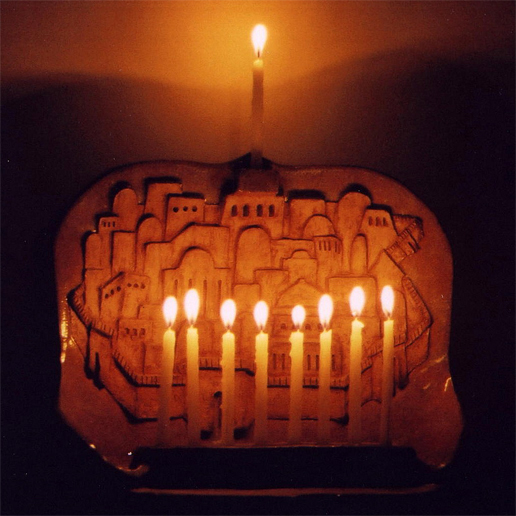|
| SHOP | • | ARCHIVE | • | MKH NEWS | • | PFI | • | SHOPPERS' UPDATE | • | HOME |
| MY LIFE |
|
|
| MY SIMCHA |
|
|
| MY YEAR |
|
|

Chanuka lights: olive oil or wax – which is best?
As every Jewish child knows, the foremost mitzvah of Chanukah is the lighting of the Chanukah candles. The mitzvah to light candles was established by the Rabbis to commemorate the famous miracle that occurred in the Beit Hamikdash. At that time, the Greeks were systematically trying to wipe out Torah and mitzvot and they had succeeded in taking over the Beit Hamikdash. As we all know, the Maccabees fought hard and won a miraculous military victory, taking back the Beit Hamikdash for the Jewish people in the process. When it was time to rededicate the Temple, however, only one jar of pure olive oil could be found that was suitable for relighting the Temple’s menorah. Miraculously, this one day supply of oil lasted for eight full days until new oil could be prepared. To commemorate this miracle, our rabbis established the holiday of Chanukah and the lighting of candles. The question is, if Chanukah is all about this miracle of the oil lasting for eight days, why do so many people today light with wax candles?
In fact, the Gemara tells us that any fuel may be used for kindling the Chanukah lights, although it states that the best way of fulfilling the mitzvah is, indeed, by using pure olive oil. This, of course, makes perfect sense because it’s the miracle of the one jar of olive oil lasting for eight days that we are celebrating. Accordingly, this is the reason given by many rishonim as to why olive oil is the preferred fuel for the Chanukah lights. The only problem is that the Gemara does not mention this reason!
The Gemara doesn’t talk about the miracle in this regard. Rather, it explains that olive oil is the preferred fuel because it draws easiest from the wick, burns the clearest and is the smoothest of all the oils, hence, rendering the steadiest flame. However, if this were the only rationale, then today, with the availability of other more efficient fuels and paraffin candles, olive oil would certainly lose its status as the most preferred option. The fact that it still remains the fuel of choice tells us that the miracle is still an important factor, although it’s played down in the Gemara.
When we compare the mitzvah of the Chanukah candles with the mitzvah of Shabbat candles, we can gain a clearer understanding of both. In the case of Shabbat candles, our rabbis permitted only olive oil. The reason is that the purpose of Shabbat candles is, ultimately, utilitarian – to provide the benefit of light in the house so that Shabbat is more peaceful and enjoyable. Our rabbis were very concerned that should the flame not burn well, a person might be tempted to adjust it to enhance the light and thereby violate Shabbat. Therefore, they only permitted smooth burning olive oil. On the other hand, with regard to Chanukah candles, their purpose is, ultimately, commemorative – for us to see them and remember the miracle of Chanukah. We are not to derive any practical benefit from them, whatsoever. In fact, if they blow out we do not even have to relight them. Hence, without concern that a person will adjust the candles, our rabbis permitted any type of fuel, although as we’ve seen, olive oil is still the best way to fulfill the mitzvah.
So, if that’s the case, how did the practice of using wax candles become so prevalent? The Rema, Rabbi Moshe Isserles (1525-1572 C.E.), writes that if olive oil is not available then one may use other smooth burning fuels and so, it became customary in Europe to use wax candles. Apparently, without the availability of good transportation, olive oil was not so easy to come by in Europe at that time. As with many customs, once established, people become attached to them. Apparently, that’s what happened here as children grew up and wanted to continue to do what their parents and grandparents had done before them.
So what about some of our new, modern, high tech options for Chanukah candles. Today we have gas flames, paraffin fuel, fiberglass wicks and, of course, all sorts of electric lights. As it turns out, modern day halachic authorities have investigated all of these and have concluded that an essential part of the mitzvah of Chanukah candles is to light them in a manner similar to the way the menorah was lit in the Beit Hamikdash. There, the menorah had both wicks and fuel. A wick is defined as an element that is consumed in the process of burning. Gas lights do not have wicks at all and wicks made of fiberglass are not consumed. Electricity of course, has neither oil nor wick and, therefore, is lacking on both counts. Hence, none of these modern day options may be used to fulfill one’s obligation to kindle Chanukah lights.
Nevertheless, in the end, no matter how you end up fulfilling the mitzvah, with olive oil or wax candles, the main thing is that we keep in mind what the Chanukah lights symbolize – namely, the victory of light over darkness, of good over evil and of the supremacy of the spiritual over the physical. May we all have a joyous Chanukah and, together with our families, bask in the warmth and glow of this beautiful mitzvah!
Rabbi Eliezer Kessler
Houston, Texas
Houston, Texas
| SUBMISSIONS | • | ADVERTISERS | • | TERMS OF USE | • | PRIVACY |
| ARTICLE ARCHIVE | • | NEWSLETTERS | • | KEYWORD SEARCH | • | HELP | • | HOME |